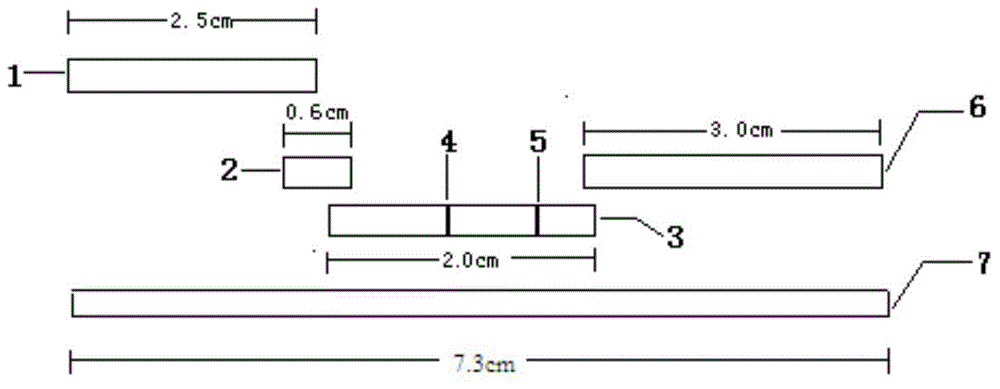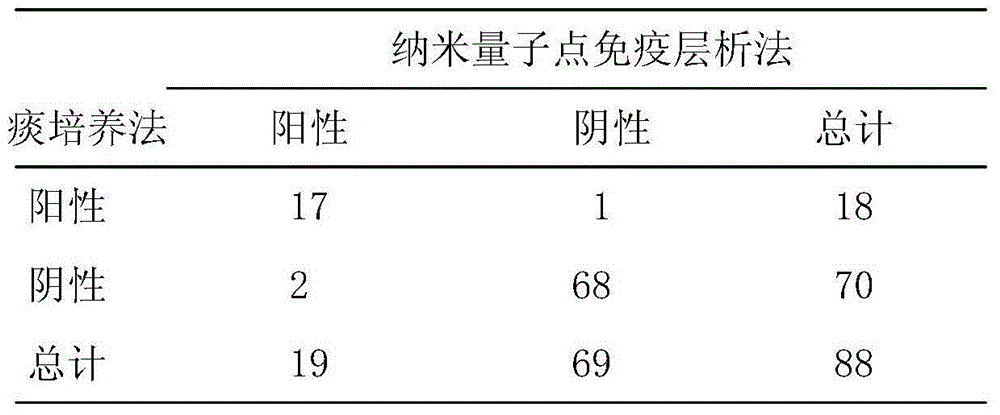Human Haemophilus influenza quantum dot immunochromatography detection card, preparation method and application thereof
A technology for Haemophilus influenzae and Haemophilus bacillus is applied in the field of medical detection, which can solve the problems of long cell culture time, complicated operation steps, and missed detection.
- Summary
- Abstract
- Description
- Claims
- Application Information
AI Technical Summary
Problems solved by technology
Method used
Image
Examples
preparation example Construction
[0076] 1. Preparation of conjugated pads
[0077] (1) Preparation and purification of recombinant P6-His fusion protein:
[0078] Bioinformatics analysis was carried out on the human Haemophilus influenzae P6 protein to obtain the peptide with the most abundant antigenic epitope in the extracellular domain of the human Haemophilus influenzae P6 protein, and to find its corresponding gene sequence; 5 of the two gene sequences Restriction sites were introduced at the 'end and 3' end respectively, and the whole gene sequence was chemically synthesized respectively, and marked as P6 at the same time. See the sequence listing for its gene sequence. The gene sequence was cloned into the expression vector pET-28a(+) according to the conventional method, and then the recombinant P6-His fusion protein was expressed. The fusion protein exists in the genetically engineered bacterium in the form of soluble expression. Purify the recombinant P6-His fusion protein in the genetically engi...
Embodiment 1
[0117] Embodiment 1 (preparation embodiment)
[0118] Conjugate pad preparation
[0119] (1) Preparation and purification of recombinant P6-His fusion protein
[0120] 1. Cloning of related genes
[0121] Bioinformatic analysis was performed on the surface protein P6 of human Haemophilus influenzae (its accession number in the NCBI protein database is AAA24994), to obtain the peptide with the most abundant antigenic epitope in its extracellular conserved domain, and to find its corresponding DNA coding sequence At the same time, the whole gene sequence was chemically synthesized after introducing the restriction site NdeI at the 5' end, the termination signal TAA and the restriction site XhoI at the 3' end (the whole sequence synthesis was completed by GenScript Biotechnology Co., Ltd., upon delivery The artificially synthesized gene fragment is connected to the vector pUC57), which is denoted as P6. The full sequence of its gene is shown in the sequence listing. Specifica...
Embodiment 2
[0147] Embodiment 2 (preparation embodiment)
[0148] Preparation of sample pads
[0149] Prepare sample pad treatment solutions with different formulations, observe the release effect of quantum dot-labeled antibodies, and optimize through multiple orthogonal experiments to obtain the optimal sample pad treatment solution formulation (that is, described in the present invention). Take a piece of glass cellulose membrane, soak it in the sample pad treatment solution for at least 3 hours, then place it in a biological safety cabinet at 37°C, ventilate and dry it, and cut it into a size of 4cm*2.5cm / strip to prepare the sample pad , Store in airtight and dry place at 25°C. Tests have proved that the use of the sample pad greatly improves the release rate of the quantum dot-labeled antibody on the binding pad and achieves a better application effect.
PUM
| Property | Measurement | Unit |
|---|---|---|
| length | aaaaa | aaaaa |
| width | aaaaa | aaaaa |
| width | aaaaa | aaaaa |
Abstract
Description
Claims
Application Information
 Login to View More
Login to View More - R&D
- Intellectual Property
- Life Sciences
- Materials
- Tech Scout
- Unparalleled Data Quality
- Higher Quality Content
- 60% Fewer Hallucinations
Browse by: Latest US Patents, China's latest patents, Technical Efficacy Thesaurus, Application Domain, Technology Topic, Popular Technical Reports.
© 2025 PatSnap. All rights reserved.Legal|Privacy policy|Modern Slavery Act Transparency Statement|Sitemap|About US| Contact US: help@patsnap.com



